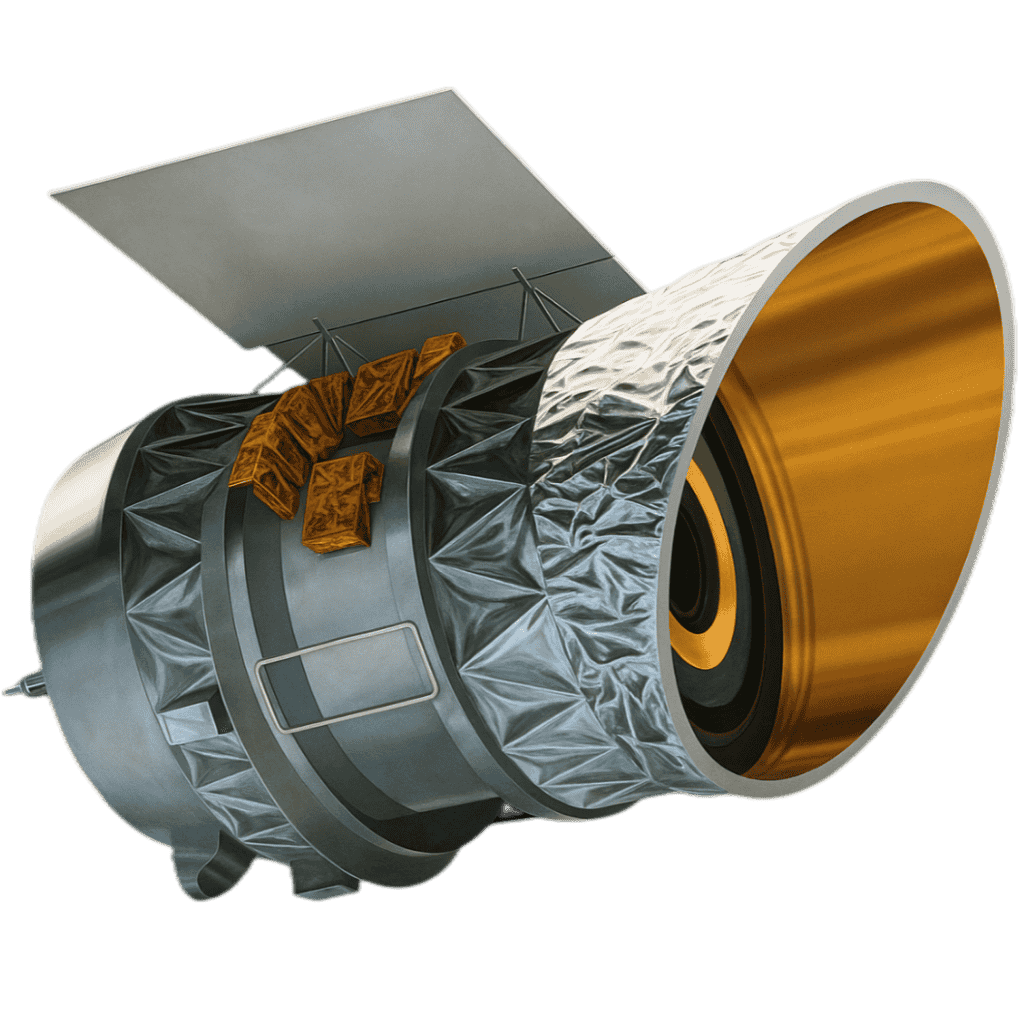Infrared Astronomical Satellite
Infrared Trailblazer
First telescope for an all-sky infrared survey

USPs
- First all-sky infrared survey, mapping 250,000 sources
- Discovered dust disks around stars, hinting at planetary systems
- Pioneered infrared astronomy and technology for future missions
- Detected six new comets, including IRAS-Araki-Alcock
- Revealed infrared cirrus—diffuse dust structures in the Milky Way
- Enabled discovery of the first brown dwarf candidate
- Mapped star-forming regions and hidden galaxies
Major Milestones
- 1983-01-25: Launched aboard a Delta 3910 rocket from Vandenberg Air Force Base, initiating its mission to conduct the first all-sky survey in infrared wavelengths.
- 1983-01-30: Entered a Sun-synchronous polar orbit at 900 km altitude and began cooling its telescope to 2 K using superfluid helium.
- 1983-03-15: Released its first infrared images, detecting cold dust clouds and stars invisible to optical telescopes.
- 1983-05-01: Completed its initial all-sky survey, cataloging over 250,000 infrared sources in its preliminary data release.
- 1983-08-15: Discovered six new comets, including IRAS-Araki-Alcock, which passed close to Earth, showcasing its ability to detect transient objects.
- 1983-11-21: Exhausted its liquid helium coolant, ending its primary mission after 10 months of operation.
- 1984-03: Published the IRAS Point Source Catalog, containing over 245,000 sources, a foundational dataset for infrared astronomy.
- 1985-12: Data contributed to the discovery of the infrared cirrus, revealing diffuse dust structures in the Milky Way.
- 1990-01: Data used to identify the first brown dwarf candidate, Gliese 229B, marking a significant advancement in stellar classification.
- 2025-07-17: Data continues to be analyzed, influencing ongoing infrared astronomy research and complementing modern missions as of today.
Cosmic Portrait
IRAS: Pioneering Infrared Astronomy
Infrared Astronomical Satellite (IRAS), launched in January 1983, was the world’s first space-based observatory dedicated to performing a full all-sky infrared survey. Developed through a collaborative effort between NASA, the Netherlands, and the United Kingdom, IRAS marked a turning point in astronomy by revealing a hidden universe invisible to optical telescopes. Over its ten-month mission, IRAS cataloged over 250,000 infrared sources, many of which were previously unknown, transforming our understanding of cosmic dust, star formation, and distant galaxies.
- Breakthrough Discoveries: IRAS was the first to detect dust disks around nearby stars—structures that pointed to the possible formation of planetary systems. It also discovered new comets, ultraluminous infrared galaxies (ULIRGs), and mapped the faint glow of interstellar dust, now known as the infrared cirrus.
- Orbit & Observation: Operating in a sun-synchronous low Earth orbit, IRAS could scan the sky in continuous strips, achieving nearly complete sky coverage during its brief mission. The satellite carried a 57-centimeter telescope cooled to just a few degrees above absolute zero using a supply of superfluid helium, critical for detecting faint infrared signals.
- Technical Milestones: IRAS introduced new technologies in cryogenics, infrared detectors, and space-based data processing. These innovations paved the way for future infrared missions and proved that infrared astronomy from space was not only possible, but essential.
- Influence on Future Missions: The legacy of IRAS can be seen in later observatories like Spitzer Space Telescope, AKARI, WISE, and Herschel Space Observatory, all of which built upon the foundations laid by IRAS’s pioneering work.
Scientific and Historical Impact
Although IRAS was operational for less than a year—its mission ending in November 1983 due to the exhaustion of its liquid helium coolant—it delivered data that would fuel astronomical research for decades. The IRAS Point Source Catalog became a critical tool for identifying targets for both ground-based follow-ups and space missions. Its discoveries reshaped our understanding of the cold universe, highlighting the importance of dust and molecules in shaping galaxies, stars, and planets.
IRAS also laid the groundwork for infrared cosmology by identifying thousands of galaxies undergoing intense, dust-obscured star formation—key to understanding galaxy evolution in the early universe. Additionally, its unexpected detection of comets and asteroids in the inner solar system broadened its impact beyond stellar astronomy.
Why IRAS Still Matters
IRAS opened a new window to the universe, revealing hidden stars and dust clouds that optical telescopes could never see.
Today, IRAS stands as a trailblazer in space-based astronomy. Its vision allowed scientists to see the universe in a completely new light—literally—by exposing the cold and dusty components that are invisible to traditional telescopes. Its contributions continue to echo through modern astronomy, serving as both a technological milestone and a scientific treasure chest for the study of the infrared cosmos.
Fun Fact
IRAS discovered the first evidence of planetary systems around other stars!